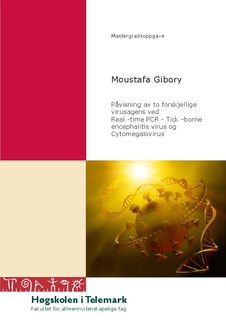Påvisning av to forskjellige virusagens ved real-time PCR - Tick-borne encephalitis virus og Cytomegalovirus
Master thesis
Published version

Åpne
Permanent lenke
http://hdl.handle.net/11250/2438917Utgivelsesdato
2013Metadata
Vis full innførselSamlinger
Originalversjon
Gibory, M. Påvisning av to forskjellige virusagens ved real-time PCR - Tick-borne encephalitis virus og Cytomegalovirus. Master thesis, Telemark University College, 2013Sammendrag
SAMMENDRAG: Et virus er et lite smittestoff som kun kan reprodusere inne i levende celler i en vertsorganisme. Virus kan infisere alle typer organismer som dyr, planter og bakterier. De finnes nesten i alle økosystemer på jorda, og er den mest tallrike type biologisk enhet. Virusene kan enten inneholde DNA eller RNA som genetisk materiale og deles i to hovedgrupper; RNA-virus og DNA-virus.. Virus kan påvises ved Real-time PCR metoden, som i denne oppgaven ble brukt til å undersøke to forskjellige virus agnes; Tick-borne encephalitis virus (TBEV) som er et RNAvirus og Cytomegalovirus (CMV) som er et DNA-virus. Tick-borne encephalitis (TBE), som forårsakes av infeksjon med TBEV, er blant de viktigste vektorbårne sykdommer hos mennesker i Europa, og er i dag identifisert som et stort helseproblem i mange land inkludert Norge. Forekomsten av TBEV i flåtten Ixodes ricinus ble undersøkt i 4 utvalgte lokaliteter langs kysten av Sør-Norge. Totalt ble 1630 flått innsamlet i 2011 og 2840 innsamlet i 2012 og analysert med in-house TBEV Real-time PCR. Resultatene fra denne delen av oppgaven bekrefter forekomst av TBEV i Norge og det ble ikke påvist TBEV frie lokaliteter i Sør-Norge. Resultatene viser også en årlig variasjon i TBEV forekomsten i flått innen samme lokalitet. Cytomegalovirus (CMV) er et herpes virus som er utbredt i dyr og mennesker. Ca. 50-60 % av befolkningen i Norge er smittet med CMV ved 20 års alder. Viruset kan overføres gjennom forskjellige måter blant annet direkte kontakt og gjennom kroppsvæsker som f.eks. spytt, urin, morsmelk og blodoverføring samt transplantasjon. Det ble etablert en Real-time PCR metode som en del av denne oppgaven for påvisning av CMV i forskjellige prøvemateriale (serum, urin og spinalvæske) og med forskjellige nukleinsyre ekstraksjonsmetoder. I tillegg ble metoden testet for spesifisitet mot andre virus agens. Resultatene fra denne delen av oppgaven viser at den etablerte/modifiserte metoden fungerte bra og har god sensitivitet og spesifisitet. ABSTRACT: A virus is a small infectious agent that can reproduce within living cells in an organism. Viruses infect all types of organisms such as animals, plants and bacteria. They are found in almost every ecosystem on Earth and are the most abundant type of biological entity. The viruses may contain either DNA or RNA as genetic material and therefore are divided into two main groups depending on the nucleic acid they contain. One of virus detection methods is Real-time PCR, which was used to investigate viral nucleic acid (RNA or DNA) of two different virus agents; Tick-borne encephalitis virus (TBEV) and Cytomegalovirus (CMV), respectively. Tick-borne encephalitis (TBE) is among the most important vector-borne diseases for humans in Europe, and is currently identified as a major health problem in many countries including Norway. We investigated the prevalence of TBEV in ticks (Ixodes ricinus) in four selected locations along the coast of Southern Norway. A total of 1630 nymphs ticks were collected in 2011 and 2840 in 2012 were selected for further analysis by in-house TBEV Real-time PCR. The results from this part of the study confirm the existence of TBEV foci in Norway. No localities without TBEV in ticks were discovered in these four locations. The results also showed a year to year variation in the number of TBEV positive pools of ticks at the same location. Cytomegalovirus (CMV) is a herpes virus widespread in animals and humans. Approx. 50- 60% of Norway's population infected with CMV at 20 years of age. The virus can be transmitted through various ways including direct contact and body fluids such as saliva, urine, breast milk and blood transfusion as well as transplantation. We established a Real-time PCR method as a part of this task for the detection of CMV in different specimens (serum, urine and cerebrospinal fluid) and using different nucleic acid extraction methods. In addition, the method was tested for specificity against other viral agents. The result from this part of the study shows that the established / modified method worked well with a good sensitivity and specificity
Utgiver
Høgskolen i TelemarkOpphavsrett
© Copyright The Author. All rights reservedBeslektede innførsler
Viser innførsler beslektet ved tittel, forfatter og emneord.
-
Inkoo and Sindbis viruses in blood sucking insects, and a serological study for Inkoo virus in semi-domesticated Eurasian tundra reindeer in Norway
Shakya, Ruchika; Tryland, Morten; Vikse, Rose; Romano, Javier Sánchez; Åsbakk, Kjetil; Nymo, Ingebjørg Helena; Mehl, Reidar Arne; Evander, Magnus; Ahlm, Clas; Vapalahti, Olli; Lwande, Olivia Wesula; Putkuri, Niina; Johansen, Wenche; Soleng, Arnulf; Edgar, Kristin Skarsfjord; Andreassen, Åshild Kristine (Peer reviewed; Journal article, 2022)Background: Mosquito-borne viruses pose a serious threat to humans worldwide. There has been an upsurge in the number of mosquito-borne viruses in Europe, mostly belonging to the families Togaviridae, genus Alphavirus ... -
Tick-borne encephalitis virus: an emerging virus in Scandinavia
Lamsal, Alaka (Doctoral dissertations at the University of South-Eastern Norway;190, Doctoral thesis, 2024-05-14)Tick-borne encephalitis virus (TBEV) causes Tick-borne encephalitis (TBE) which is an infection of the central nervous system that can lead to encephalitis. TBE cases are increasing in Scandinavia over the last few decades ... -
Prevalence of tick borne-encephalitis virus (TBEV) and phylogeographic structure of its vector Ixodes ricinus
Kiran, Nosheen (Master thesis, 2017)Ixodes ricinus is the most common vector in Europe and it is the primary vector for tick-borne encephalitis virus (TBEV) in Norway. Tick-borne encephalitis (TBE) cases have been reported yearly from Norway since the first ...